|
History of the mining activity in Tunisia
The mining activity in Tunisia gets way back in time to the Roman era, which was characterized by a small-scale exploitation of the outcropping indications. This activity witnessed a sensible quasidevelopment during many centuries and under different empires, such as Berber, Roman, Arab and French. During the modern era (from 1890 until nowadays), too many stratums have been discovered.
Thus, the production of phosphate started in 1996, that of iron in 1906 and that of the concentrated Plumb and zinc in 1892.
Today’s mining activity in Tunisia
Actually, the deposit and mineral-index map of Tunisia took out around 600 deposits and indices, from which over 50 deposits were exploited and some are still in activity.
The 2005 assessment of the iron-ore market is summarized as follows.
- 55 MT of the iron ore (10 MT of which is extracted from the north basin: Tamerza, Dhouahria and Boukhchiba, and 45 MT of which are from J.Jerissa in the Dome zone).
- 2,3 MT plumb iron ore
- 2 MT of zinc iron ore
- More than 25 MT of salt was extracted from sea and the Sebkhet along the cotes and is composed of NaCl and a marginal quantity of brome.
- 0,9 MT of fluorine spare and 0,6 MT of Barytine and 322 MT of phosphate.
The best known and exploited deposits are located in :
-
The volcanisme or naps zone. This zone covers an area of 6000 Km2. The exploited deposits are : Tamera Fe J. Hallouf Pb–Zn, Oued el Maden and El Arja Hg and Fej Hsine Pb-Zn.
The tonnage of iron ore merchandise that is produced in the volcanism zone at the end of 2005 is evaluated as follows :
1MT Pb, 272 000 T Zn, 9 MT Fe and 74 000 T Zn Hg
The deposit of J. Hallouf-Bou Aouane provided: 565000 T Pb and 82000 T Zn
The deposit of El Arja: 74000 T of mercury Hg. The most well
- Diapir or dome zone. This zone covers an area of 8000 Km2. The most well known deposits that the majority of which have been exploited since the end of the XIX century are: Bougrine Zn-Pb, Fej Lahdoum Zn-Pb, BaSo4 and CaF2, Jerissa’s iron.
The tonnage of the concentrated-iron-ore merchandise of the dome zone by the end of 2005 is evaluated as follows :
1MT Pb,1.5 MT Zn, 82000 T CaF2, 400000T BaSo4, 41 MT Fe.
The Bougrine deposit provided: 87000 T Pb and 640000 T Zn.
That of Fej Lahdoum: 81000 T Pb and 150000 T Zn. That of Boujabeur: 57000 T Pb , which is argentiferous with argent content that exceeds 500g/T of concentrated Pb. The iron deposit of Jerissa provided: 40 MT of Fe.
- Central Tunisia and the North-South axis. This zone covers an era of 43.000 Km2. The mining activity in this territory is not well developed in comparison with the two other domains in the north, despite the several deposits that were listed in the region (beginning of the previous century) and which were modestly and essentially exploited in Pb-Zn :
As a rough guide, here are the quantities of the iron-ore merchandises that are produced in some deposits like: Loridga (3.500T of calamine), Jebell Trozza (97.000 of Pb and 3.000 of Zn), Jebel Touila (7.700T of Zn and 6.200T of Pb), Jebel Labeid (2.200T of lead), J.Chaambi (11000T Pb) and J.Ajred (12000T Pb and 15000T Zn).
The tonnage of the iron-ore merchandize of central Tunisia revealed 120000T of Pb and 20000T of Zn by the end of 2005.
For the time being, this zone started to attract foreign operators to the important potentialities that this zone has had, and which are still to be discovered, such as Australia’s BHP and previously the Italians.
The north east of central Tunisia, in the level of the north-south axis, which is known as the Fluoride Province, is characterized by its content of Fluorine and Barytine.
The most famous deposits of this province are those of: Hammam Zriba, which provided 732000T of fluorine spar and 113000 of Barytine. Hammam Jdidi, supplied 37000T of Fluorine spar and 113000T of Barytine. Plumb and Zinc concentration area also extracted from this zone, such as J.Ressas: 122000T of Pb and 165000T of Zn and Sidi Taya: 41000T of Pb. The tonnage of the iron-ore merchandise by the end of 2005 revealed 791000T of Fluorine spar, 130000T of Barytine, 163000T of Pb and 165000T of Zn.
-
Gafsa’s basin: This basin is famous for its content in phosphate in the side of Meknassi and the north basin of Sraa Ouertane and Kalaa Khasba. The certain reserves of phosphate, which are identified in Gafsa’s basin are on the order of 1.5 billion of tones, about 24% of P2O5. In Sraa Ouertane, the reserves are of the order of 2.5 billion of tones, about 15% of P2O5.
The tonnage of phosphate which is extracted from Gafsa’s basin and if desired of Meknassy is on the order of 300MT by the end of 2005, the principal mines from which are Métlaoui, Moularés, Redyef and M’dhillah.
-
The north basin: approximately 15MT of metallurgical phosphate are extracted from Kalaa Khasba.
|
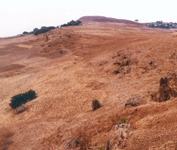
Volcanic structure of Oued Belif, in the Nafza region in the north, exploited currently for iron.
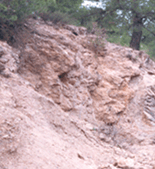
Zone of mineralized contact in Zn-Pb at the diapir level of Sakiet of Tajerouine.
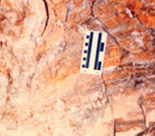
Massive Celestine in Doghra mine in the dome zone.
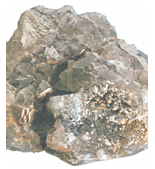
Massive fluorine in the Hamem Zriba mine in Zaghouan in the North-south axis.
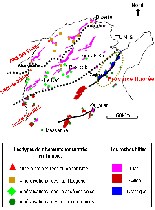
Repartition map of the principal types of the known deposits in Tunisia.
(Larger image - click here)
|



